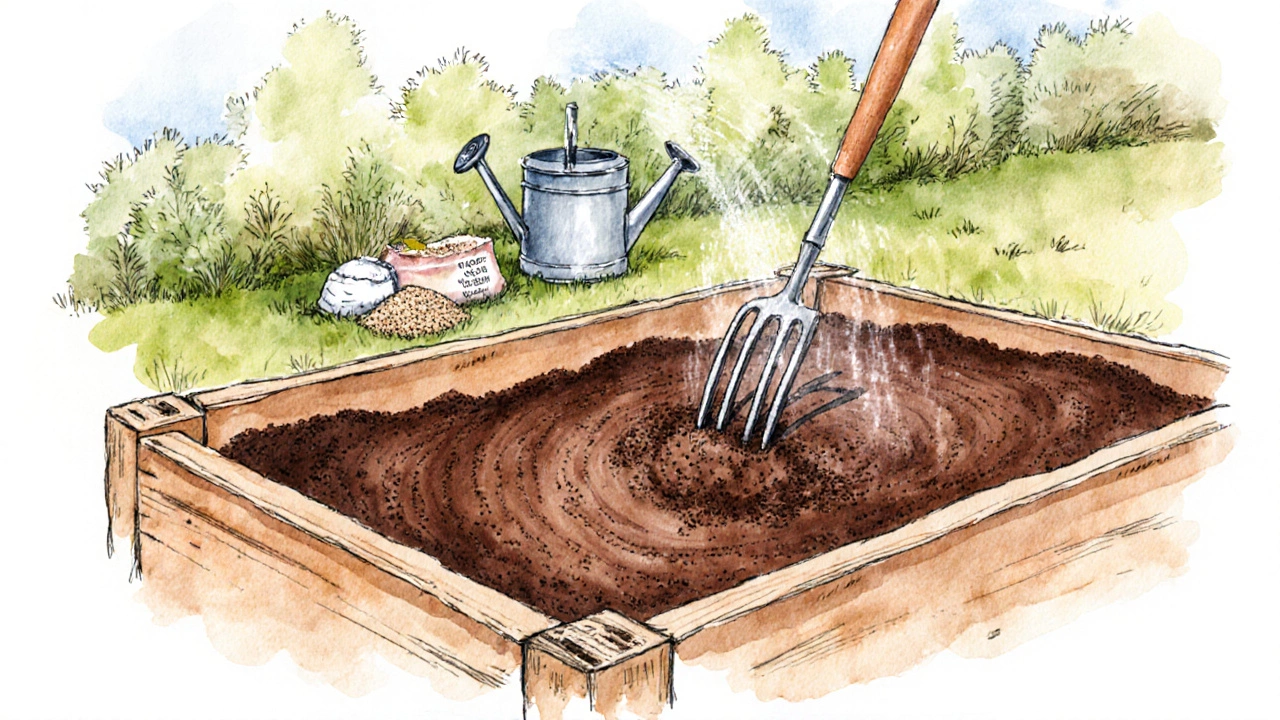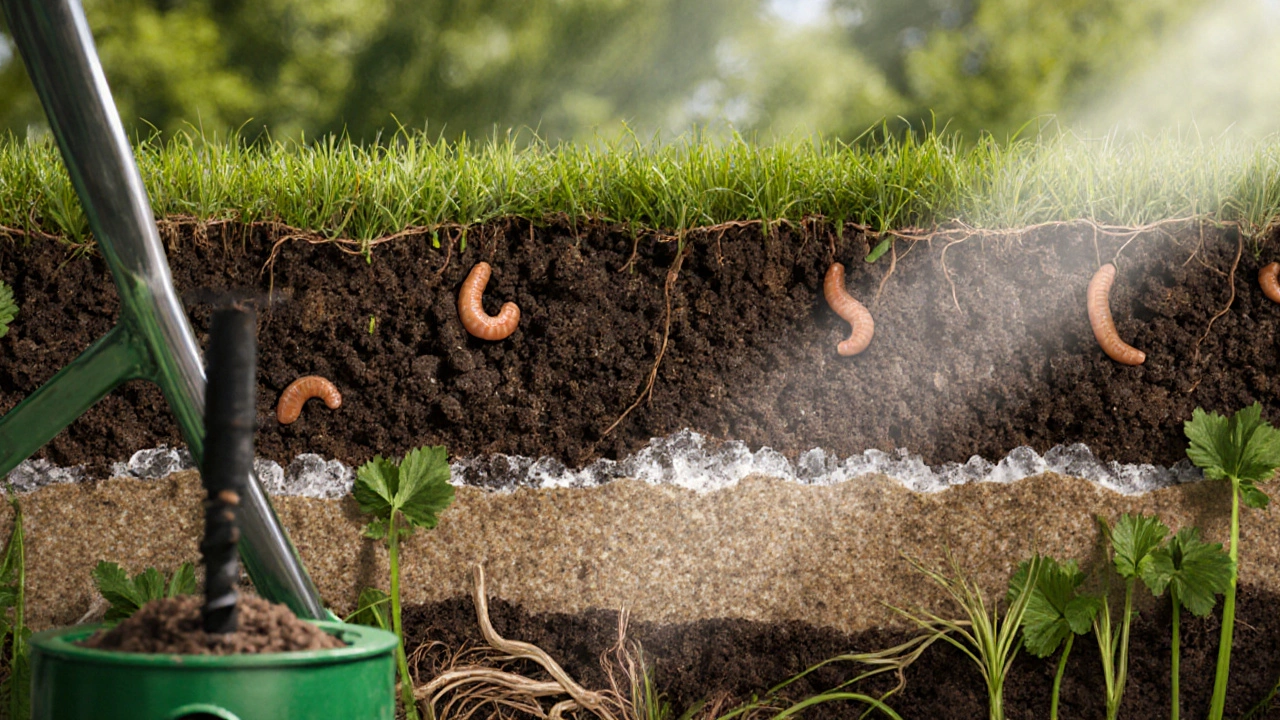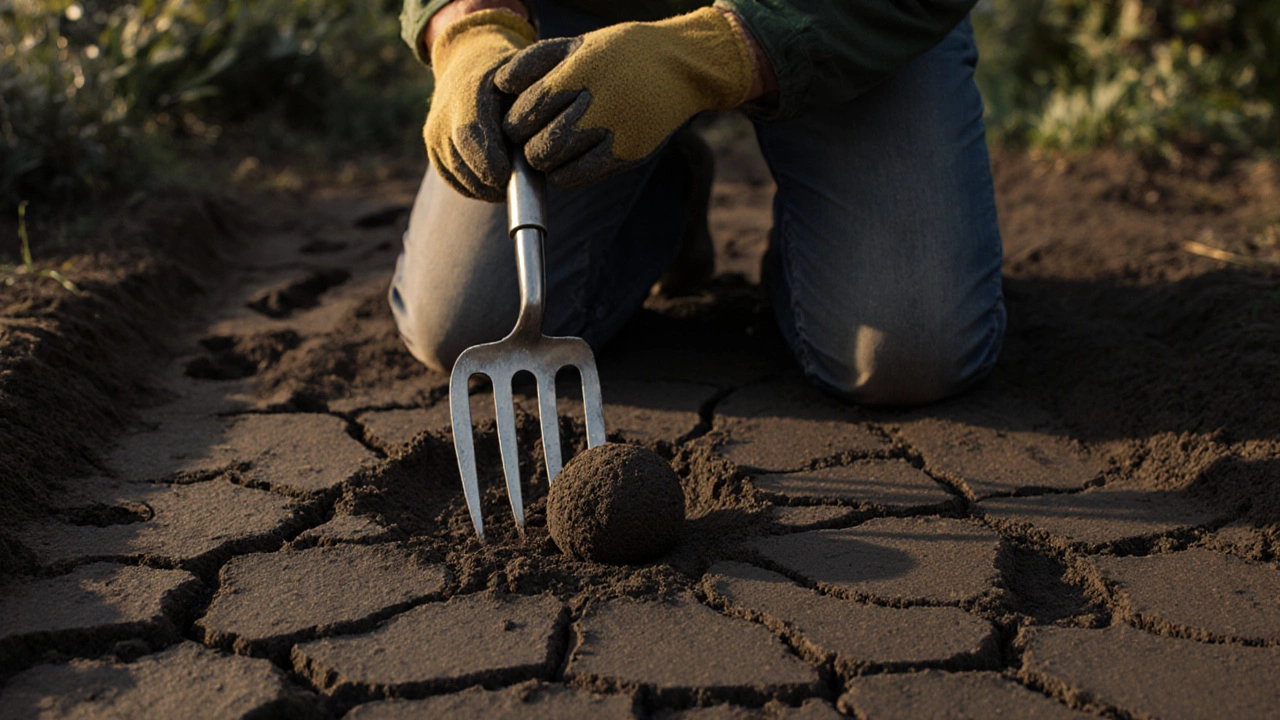Soil Conditioner Calculator
Soil Conditioner Calculator
Calculate how much soil amendment you need based on your garden size and soil type.
Recommended Amendment
Amount Needed
Note: Amounts are approximate and may vary based on soil conditions and application methods.
When garden soil gets hard, soil is the growing medium that holds water, nutrients, and air for plant roots but it can become compacted, crusty, and difficult to work with. If you’ve ever tried to dig a hole and felt like you were cutting through a brick, you know the frustration. The good news? You can bring back that fluffy, crumbly feel with a handful of everyday materials and a few easy routines.
Why Does Soil Turn Hard?
Before you scramble for a fix, it helps to know what’s causing the problem. The most common culprits are:
- Compaction - heavy foot traffic, wheelbarrows, or machinery press soil particles together, squeezing out air pockets.
- High clay content - clay particles are tiny and stick together, especially when wet, creating a dense matrix.
- Low organic matter - without enough decayed plant material, there’s nothing to keep soil particles apart.
- Improper watering - over‑watering followed by rapid drying creates a hard crust on the surface.
Once you spot the cause, you can pick the most effective remedy.
Quick Soil Test: Feel It, Not Just See It
Grab a handful of damp soil and squeeze it. If it forms a smooth ball that cracks cleanly, the texture is fine. If it feels like a rubber ball or leaves a muddy streak, it’s too dense. You can also dig a small pit, let it dry for a day, then press a screwdriver in - resistance means compaction.
1. Add Organic Matter - Compost, Leaf Mold, and Manure
Organic matter is the superhero that loosens soil by creating tiny channels for air and water. Here’s how to use it:
- Spread a 2‑3inch layer of compost (aged kitchen scraps, garden waste, or commercially‑made) over the hard area.
- Work it gently into the top 6‑8inches with a garden fork or broadfork. Avoid turning it too deep; you want it near the root zone.
- Water lightly to help microbes break down the material. Within a few weeks, you’ll notice the soil feeling softer and lighter.
If you have plenty of fallen leaves, let them decompose into leaf mold first - it’s even better at improving texture than raw leaves.
2. Use Gypsum for Clay‑Heavy Soil
Gypsum (calcium sulfate) doesn’t change pH, but it replaces sodium ions that bind clay particles together, letting them separate. It works best when you have a clay‑rich garden.
- Measure the area - apply about 40lb (≈18kg) of gypsum per 1,000sqft (≈93sqm).
- Broadcast the gypsum evenly over the surface.
- Incorporate it into the top 6inches with a fork or rototiller.
- Water well; the mineral needs moisture to move into the clay matrix.
Gypsum works gradually, so repeat once a year for stubborn clay.

3. Add Sand or Grit for Better Drainage
For soils that feel slick and stay wet, a gritty amendment can improve drainage and break up compaction.
- Use coarse sand (playground‑grade) rather than fine beach sand - fine sand can make the problem worse.
- Mix 1part sand with 2parts existing soil, aiming for a 25% sand blend.
- Work the mixture thoroughly; you’ll notice a crunchier feel as you dig.
This technique is especially useful for raised beds where you can control the mix from the start.
4. Plant Cover Crops - Green Manure
Living roots act like natural aerators. Fast‑growing cover crops such as clover (a type of cover crop that fixes nitrogen and creates a tangled root network), rye, or buckwheat add organic matter while the plants are alive.
- Sow the seed in late summer or early spring over the compacted zone.
- Let the crop grow for 6‑8 weeks, then mow it down and work the cut material into the soil.
- Leave the roots to decompose; they leave channels that stay open for future plantings.
Cover crops also suppress weeds and improve soil fertility - a win‑win.
5. Core Aeration and Proper Tilling
If your garden sees a lot of foot traffic or heavy equipment, the soil may need mechanical relief.
- Core aeration (removing small plugs of soil with a garden aerator) creates permanent air pockets. Do it in early spring or fall when the soil is moist but not soggy.
- After aerating, spread a thin layer of compost or sand to fill the holes - the material settles in and keeps the soil loose.
- When you till, use a broadfork or a fork‑type tiller instead of a heavy rototiller. A light, shallow approach prevents breaking down the newly added organic matter.
6. Mulch to Protect and Soften Over Time
A mulch blanket of shredded bark, straw, or leaf litter does more than look tidy. It cushions the soil from compaction, keeps moisture steady, and slowly adds organic matter as it breaks down.
- Apply 2‑3inches of mulch over beds and pathways.
- Refresh the layer annually, especially after the winter.
- Avoid piling mulch right against plant stems - that can cause rot.
Over a season, the mulch will turn into humus, further improving that soft, crumbly feel you’re after.

Quick Comparison of Common Soil‑Softening Amendments
| Amendment | Type | Best For | Application Rate | Time to See Results |
|---|---|---|---|---|
| Compost | Organic | General softening, nutrient boost | 2‑3inches top‑layer | 2‑4weeks |
| Leaf Mold | Organic | Improving texture in sandy soils | 2‑3inches | 1‑3weeks |
| Gypsum | Mineral | Heavy clay soils with sodium issues | 40lb per 1,000sqft | 4‑6weeks |
| Coarse Sand | Mineral | Water‑logged or heavy soils needing drainage | 25% of total soil volume | Immediate to 2weeks |
| Cover Crops (e.g., clover) | Living | Long‑term soil health, aeration | Seed at 20‑30lb/acre | 6‑8weeks (growth), longer after incorporation |
Preventing Soil Hardening in the Future
Once you’ve softened the soil, keep it that way with a few habits:
- Lay down mulch year‑round to cushion foot traffic.
- Avoid walking on wet beds - let the soil dry a bit before stepping on it.
- Use raised beds or pathways for heavy equipment instead of stepping directly on planting areas.
- Refresh organic matter annually; a thin layer of compost each fall does wonders.
- Rotate crops and include a cover‑crop year to maintain root channels.
With these practices, the soil stays loose, porous, and ready for whatever you plant next.
Checklist: Bring Back Soft Soil Today
- Identify the cause - compaction, clay, or low organics.
- Choose the right amendment (compost, gypsum, sand, or cover crop).
- Apply at the recommended rate and work it into the top 6‑8inches.
- Water lightly to activate microbes or mineral reactions.
- Repeat annually or as needed, especially after heavy rain or foot traffic.
Frequently Asked Questions
Can I soften soil without digging?
Yes. Surface applications of compost, mulch, or gypsum followed by watering can improve texture without a full dig. For severe compaction, core aeration is the least invasive mechanical option.
Is sand safe for all soil types?
Only coarse sand should be used and only when the existing soil is heavy or poorly draining. Adding fine sand to already sandy soil can create a cement‑like mixture.
How often should I apply gypsum?
Apply once a year in early spring for persistent clay issues. Over‑application won’t hurt, but it’s unnecessary and adds cost.
Will compost alone fix a compacted lawn?
Compost helps, but a compacted lawn usually needs aeration first. After aerating, spread a thin compost layer to fill the holes and improve organic content.
Is there a quick DIY method for a small raised bed?
Mix equal parts garden soil, compost, and coarse sand, then add a handful of gypsum if the soil feels heavy. The blend stays loose for years without extra effort.
